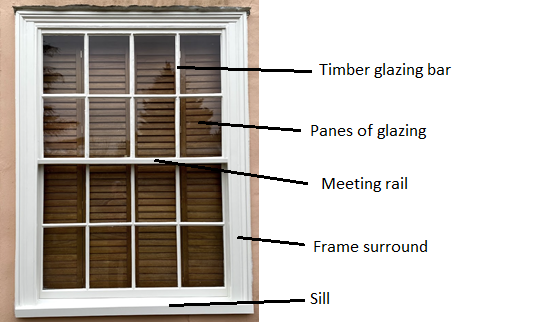Most Common Reasons Windows Leak
When heavy rain hits, the last thing you want is water leaking through your windows. These leaks not only disrupt the comfort of your home but can also cause significant damage. Understanding why windows leak is key to preventing this issue and keeping your home dry and secure. Let’s dive into the common causes of window leaks and how to address them.
Key Takeaways: Common Causes of Window Leaks
FREE window assessment!
The Anatomy of a Window
Knowing the anatomy of a window is crucial to understand how leaks occur. A window is made up of the frame (structural support), the sill (directs water away), the pane (glass component), and seals (prevent water and air entry). These elements are integral for window integrity but can also be the leak’s source. For example, leaks can happen if the frame warps, seals deteriorate, or the sill is improperly sloped or damaged. Recognizing these vulnerabilities is key to addressing leaks effectively.
Common Causes of Window Leaks
Understanding the reasons behind window leaks during rainfall is crucial for effective prevention and repair. Here, we delve into the most common causes that compromise window integrity and allow water to invade your living spaces.
Improper Installation
One of the primary culprits of window leaks is improper installation. Whether due to incorrect measurements, poor sealing, or failure to ensure the window is level and plumb, improperly installed windows are prone to leaks. Even minor installation errors can leave gaps or misalignments that become pathways for water to enter, especially under the pressure of heavy rainfall.
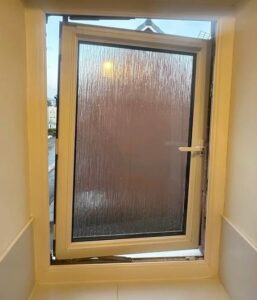
Wear and Tear
Windows, like all parts of a home, are subject to wear and tear over time. Exposure to extreme weather conditions, fluctuating temperatures, and the natural aging process can degrade window materials. Wooden frames may rot or warp, while metal frames might corrode or expand, compromising the window’s ability to keep water out. Regular inspection can help identify these issues before they lead to leaks.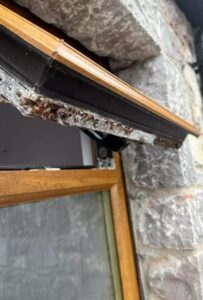
Faulty Seals
Sealant failure is a common issue that leads to window leaks. Window seals are designed to fill gaps and prevent water and air from passing through. Over time, seals can dry out, crack, or shrink, losing their effectiveness. This deterioration can be accelerated by environmental factors such as UV light exposure and temperature extremes, making older windows particularly susceptible to seal-related leaks.
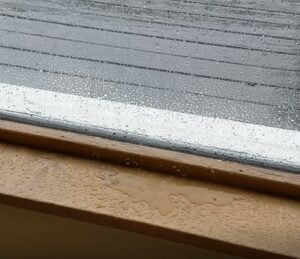
Clogged Weep Holes
Weep holes are small openings designed to drain away water that collects in a window’s frame or sill. When these holes become clogged with debris, water can back up and overflow into the home. Regularly checking and cleaning weep holes are essential preventative measures to ensure they function as intended, especially in areas prone to heavy rains or where windows are exposed to dirt and foliage.
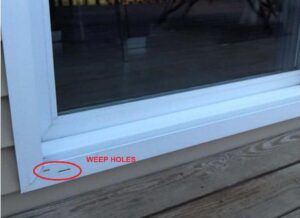
Damaged or Obstructed Drainage Paths
In addition to weep holes, windows often rely on properly designed drainage paths to channel water away. If these paths are damaged or obstructed, water can pool and eventually find its way through vulnerabilities in the window’s defenses. Ensuring that sills and surrounding areas are clear of debris and in good repair is crucial to maintaining effective water drainage.
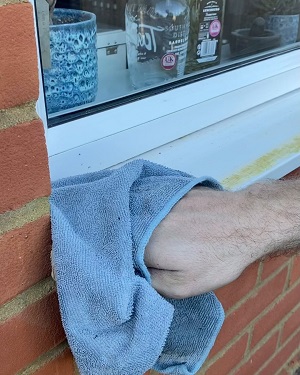
By addressing these common causes of window leaks, homeowners can significantly reduce the risk of water damage during rainstorms. In the following sections, we will explore how to diagnose specific leak sources and implement effective preventive measures and fixes to keep your windows watertight.
Expert Tips
Precision Matters: Even slight inaccuracies in window installation can lead to leaks. Ensuring windows are properly aligned and installed is crucial.
Invest in Quality: High-quality materials and sealants are more resilient against weather and wear. This investment pays off by reducing the need for frequent repairs.
Regular Checks: Routine inspections can catch early signs of potential leaks, such as sealant cracks or frame warping. Catching these issues early often means simpler, less costly repairs.
Understand the Fix: Different issues require different solutions. It’s important to correctly diagnose the problem to apply the most effective fix.
When to Call a Pro: Some repairs are best left to professionals. If you’re unsure, seeking expert advice can prevent further damage.
Diagnosing Window Leaks
Identifying the precise source of a window leak is essential for implementing the correct repair strategy. Water can travel in deceptive ways, making it challenging to pinpoint the exact entry point. Here’s a step-by-step guide to help you diagnose window leaks effectively.
Visual Inspection: Start with a thorough visual inspection of the window’s interior and exterior. Look for signs of water damage, such as staining, mold, or peeling paint. Pay close attention to the window frame, sill, and seals for any visible cracks, gaps, or deterioration.
Hose Test: With the help of a partner, use a garden hose to simulate rainfall around the window. One person should stay inside near the window to observe any water intrusion while the other gently sprays water on the window’s exterior. Start at the bottom and gradually work your way up to isolate the leak source. Remember, water can travel downwards, so the entry point might be higher than where the water appears inside.
Check the Seals and Weatherstripping: Inspect the seals and weatherstripping around the window for any signs of wear or damage. These components are often the first line of defense against water intrusion and can be the culprit behind leaks.
Examine the Weep Holes: Ensure that the weep holes are clear and unobstructed. Clogged weep holes can cause water to back up and enter the home instead of draining away as intended.
Assess the Window’s Alignment: Misalignment can lead to improper sealing and gaps. Check if the window operates smoothly and closes tightly. Misaligned windows may require adjustments or shimming to improve their seal.
Determine if Condensation is a Factor: Sometimes, what appears to be a leak is actually condensation, which can accumulate on the inside of windows due to high humidity levels inside the home. This issue points to the need for improved ventilation or humidity control rather than waterproofing.
By systematically approaching the diagnosis process, you can identify the specific issues contributing to window leaks. Once the source of the leak has been determined, you can proceed with the appropriate repairs or adjustments to remedy the problem.
FREE window assessment!
Preventative Measures & Fixes
Preventing window leaks is often more cost-effective and less frustrating than dealing with the aftermath of water damage. Here are some key strategies and fixes for maintaining watertight windows:
- Regular Maintenance: Conduct bi-annual inspections of your windows, especially before and after the rainy season, to check for signs of wear or damage.
- Re-sealing Windows: Apply a fresh bead of high-quality caulk around window frames and seals as needed to fill in gaps and prevent leaks.
- Repairing or Replacing Damaged Components: Address any issues with window components promptly. In some cases, repairing or replacing damaged parts is necessary to ensure a proper seal.
- Professional Help: When in doubt, or if the problem persists despite your efforts, consult a professional. They can offer expert advice, perform detailed inspections, and carry out repairs that might be beyond the scope of DIY fixes.
In addition to routine maintenance, reglazing windows is a crucial step to improve their durability and insulation. This process can significantly enhance your home’s defense against leaks. Check our our detailed guide on how to effectively reglaze your windows.
Conclusion: Take Action to Protect Your Home
Protecting your home from window leaks is an ongoing commitment that requires proactive steps. Understanding the causes and potential issues is the first step, but taking action is crucial. Regular maintenance and early detection are key to preventing costly repairs and damage. Schedule inspections, seal gaps promptly, and address any signs of wear or damage without delay. Your efforts in maintaining your windows not only save you money in the long run but also ensure your home remains a comfortable and secure haven, rain or shine.

Khalil is the owner of Splendid Window Glass Repairs and has over 8 years experience as a glazier specialising in window glass repair, replacement and installations. Khalil takes great pride in his work and prides himself on providing an excellent service to all of his customers, no matter how big or small the job may be.

